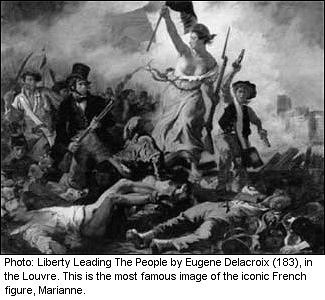| |
| |
The
original Marianne |
|
|
| |
 |
|
|
And what's Marianne
Marianne is present
everywhere in France and holds a place of honor in town halls and law courts.
She symbolizes the "Triumph of the Republic", a bronze sculpture
overlooking Place de la Nation in Paris. Her profile stands out on the
official seal of the country. It is engraved on coins and drawn on stamps and
banknotes. Marianne is considered as the most prominent depiction of the French
Republic.
But who is this women, presented, by the artist Daumier, as a mother nursing two children, or, by the sculptor Rude, as an angry
warrior voicing the Marseillaise on the Arc de Triomphe, or,
by the painter Delacroix, as representing Liberty leading the people on the
barricades, and where does she come from? One thing is certain. Her image never
leaves the French indifferent. In the last two wars, certain people worshipped
her just like a saint. Others, who were anti-Republican, often dragged the mud.
|
|
|
|
|
|
|
|
|
|
|
|
|
| |
|
| |
|
| |
|
| |
|
| |
|
| |
|
| |
|
| |
A New government logo |
| |
 |
|
Bleu-white-red, Marianne,
Liberté-Egalité-Fraternité, the
Republic: these powerful symbols represent France and its values. They have now
been combined in a new "identifier" created by the French government.
Blue: symbol of the monarchy, White: Color of Paris,
Red: symbolizing the blood poured during the
French revolution.
|
|
|
|
|
|
|
|
|
|
 |
|
 |
|
 |
|
|
|
|
|
|
|
|
|
 |
|
 |
|
 |
|
|
|
|
|
|
|
|
|
 |
|
8 mars 2000,
at 11h30 Catherine Trautmann, the French culture minister had a
meeting with Laetitia. |
|
|
? |
|
|
|
|
|
|
|
|
|
|
|
|
|
|
| |
|
| |
|
| |
|
| |
|
| |
|
History of Marianne. |
|
|
| |
According to
the story, it appears that in 1797 when seeking a pleasant name of
the Republic, Barras, one of the members of the Directoire, during
an evening spent at Reubell's, asked his hostess's name;
"Marie-Anne," she replied. "Perfect," Barras
exclaimed. "It is a short and simple name which befits the
Republic just as much as yourself, Madame."
This anecdote contradicts a recent discovery
which established that the fist written mention of the name of
Marianne to designate the Republic appeared in October 1792 in
Puylaurens in the Tarn department near Toulouse. At that time,
people used to sing a song in the Provencal dialect by the
poet Guillaume Lavabre: "La guérison de Marianne"
(Marianne's recovery) At that time the account made of
their exploits by the Revolutionaries often contained a reference to
a certain Marianne wearing a Phrygian cap (or Marie-Anne, a popular
name in the French countryside then). This pretty girl aroused the
"sans-culottes" and looked after those wounded in
the many battles and clashes across the country.
Today, Marianne remains as attractive as
ever. |
|
| |
|
| |
|
|
|
|
| |
|
| |
|
| |
|
| |
|
| |
|
|
|
|
|
|
|
|
|
|
|
|
|

